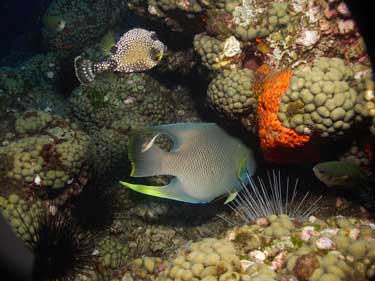Texas OneGulf Launches Research Response to Gulf of Mexico’s Flower Garden Die-Off

Experts with the Texas OneGulf Center of Excellence, led by the Harte Research Institute (HRI) for Gulf of Mexico Studies at Texas A&M University-Corpus Christi, are responding after a die-off of corals and other invertebrates was observed in the Gulf of Mexico’s Flower Garden Banks National Marine Sanctuary off the coast of Galveston. The mortality event is just the most recent in a series of incidents that have been noted off the Texas Gulf Coast this summer.
Flower Garden Spawn: Photo credit: tamuccmarcom
Sport divers aboard the M/V Fling reported the die-off last week after finding patches of white mat coating the previously vibrant reef. Texas OneGulf researchers worked over the weekend to shift resources to respond to the unusual mortality event, which has now been confirmed in multiple locations on the East Flower Garden Bank. The West Flower Garden Bank appears to remain unaffected.
Due in part to their distance from shore, the Flower Garden Banks are touted by scientists as one of the healthiest coral-reef systems in the Western Hemisphere, so the discovery of unprecedented numbers of dead or dying corals, sponges, brittle stars, calms and other invertebrates in large, separate locations is a disturbing puzzle for scientists.
HRI Director Larry McKinney, who leads the Texas OneGulf Center of Excellence, said the multidisciplinary consortium of research institutes was created to provide quick scientific response and problem solving to events like the Flower Gardens incident.
On Saturday, Texas OneGulf collaborator Dr. Tony Knap, director of the Geochemical and Environmental Research Group at Texas A&M University, traveled with his team to begin the process of sampling and preparing to deploy underwater drones to help determine what could be causing the mortality event.
Knap received a Texas OneGulf grant to operate the underwater gliders primarily to study hypoxia, a phenomenon caused by freshwater and excess nutrients that can create pockets of low oxygen that can kill less mobile marine species and drive others away from habitats. After conducting preliminary sampling this weekend, Knap plans to deploy the gliders this week to spend 8 weeks patrolling the Flower Garden Banks to collect data on water salinity, oxygen, temperature and chlorophyll levels and help research the cause of the die-off.
“It’s fortunate that we had these funds to be able to respond rapidly to such an unprecedented event,” Knap said. “The Flower Garden Banks are thought to be one of the most resilient coral reef systems in the Gulf and Caribbean. No one’s ever seen anything like this before.”
HRI has also offered to assist Knap and the Flower Garden Sanctuary staff in their investigation. In August, the institute will take its annual Flower Garden Banks cruise aboard the M/V Fling with more than 20 student and research staff divers who can assist with sampling and research if necessary.
Several factors could have caused the mortality event, according to National Oceanic and Atmospheric Administration officials, including a chemical spill, disease, or poor water quality.
Other odd marine phenomena have been reported across the Texas Coast this summer, including a hypoxic event in June off the beach at Port Aransas that killed crabs, starfish and other bottom-dwelling marine animals and sent them washing up on the beach by the thousands. Dr. Greg Stunz, HRI Endowed Chair for Fisheries and Ocean Health and Director of the Center for Sportfish Science and Conservation, said his team has also noted large schools of Red Snapper normally abundant on nearshore artificial reefs disappearing during periods of low oxygen. Unlike bottom-dwelling crabs and starfish, these animals are highly mobile and able to swim to escape hypoxic events.
Widespread rains in the spring may be contributing to increased hypoxia along the Texas coast.
“These incidents are what the Texas OneGulf Center of Excellence was built for,” McKinney said. “We have a wide pool of experts with a variety of specialties that can be assembled and deployed to ensure that the best science is available to quickly respond to any challenges our Gulf might face.”
About Texas A&M University-Corpus Christi: Offering more than 80 of the most popular degree programs in the state, Texas A&M-Corpus Christi has proudly provided a solid academic reputation, renowned faculty, and highly rated degree programs since 1947. The Island University has earned its spot as the premier, urban doctoral-granting institution in South Texas, supporting a UAS test site, two institutes and more than 20 research centers and labs. Discover your island.

